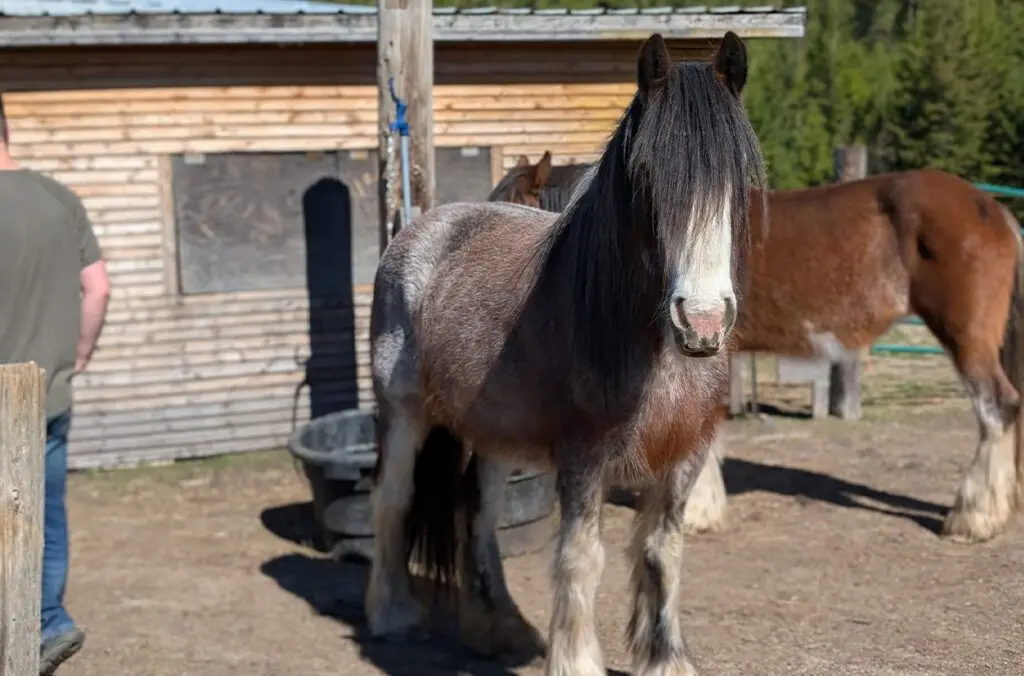PULLMAN, WA – Unusual cases are part of the job for veterinarians at Washington State University, but a horse with nearly 100 pounds of sand and gravel in its gut was still quite a surprise.
How the 11-year-old gypsy-Clydesdale cross — also known as a North American destrier — mare named Calliope managed to fill her belly with that much gravel is still an unanswered question, but the buildup led to a severe case of what is commonly known as sand colic, requiring a nearly two-week stay at the Veterinary Teaching Hospital, a lifesaving emergency surgery and the efforts of a team of WSU specialists to save her life.
“At WSU, we have a full team of specialists — from medicine, anesthesiology, and surgery to cardiology — who work together to provide the best care for complex cases like Calliope’s,” said Dr. Erin Pinnell, an equine internal medicine veterinarian who helped oversee the Clydesdale’s care. “When horses are really sick or critical, having this multidisciplinary expertise makes all the difference.”
Calliope is one of eight horses under the care of Ally Sisco north of Spokane. As an experienced horse owner, Sisco initially recognized something was off with Calliope when the mare showed no interest in her breakfast.
“That was weird for her because she’s definitely into her food,” Sisco said. “She was also laying down a lot more than normal. She likes to lay down frequently, but she was laying out flat, which I thought was a little weird because she only does that when it’s really sunny, and it wasn’t that sunny.”
Sisco administered Banamine, a drug commonly used to treat mild colic, and began walking Calliope to help her pass whatever was causing the discomfort. When that didn’t work, she loaded the mare into a trailer and took her for a drive — a common trick among horse owners to get things moving.
Showing no improvement, Sisco sought the advice of a local veterinarian who recommended immediately taking the mare to WSU. Once in Pullman, Calliope was diagnosed with sand colic, a painful and potentially serious condition in horses caused by the accumulation of sand or gravel in the intestines, leading to irritation, inflammation or blockage of the digestive tract. Annually, WSU typically treats 10 to 15 cases, many of which are managed with fluids and supportive care. Severe cases require surgery.
WSU clinicians hoped supportive care would be enough for the mare, but a week after arriving at the hospital, she took a downturn and was rushed into surgery.
Soon after being placed under anesthesia, Calliope developed a potentially fatal arrhythmia known as ventricular tachycardia.
“Without the quick thinking and cooperative efforts of faculty and personnel from equine medicine, equine surgery, anesthesia, and cardiology, this mare would have died,” said Dr. Deb Sellon, an equine internal medicine veterinarian at WSU.
Once stabilized, the surgical team was able to remove about 80% of the sand and gravel before ending the procedure to reduce her risk under anesthesia.
“I don’t think anybody really knew just the extent of how much she had in there,” Sisco said. “When they told me it was around 100 pounds, I was so surprised. I’ve been looking all over my property trying to find where she might have gotten into it — I can’t find it anywhere.”
Calliope returned home 11 days after surgery and is now several months into recovery. While she is doing well, she’ll need follow-up imaging to ensure the remaining material has passed.
“This was the first time I have ever taken a horse to WSU. They took great care of her,” Sisco said. “When I visited, she looked clean and shiny, and they even braided her mane. It looked like they were really enjoying her, which was nice.”
To help prevent sand colic, Pinnell recommends not feeding horses directly on the ground and seeking veterinary care early if a horse shows signs of colic. While ground feeding can contribute to the problem, it’s not always the cause — as in Calliope’s case, where she was never fed on the ground.
“We want owners to know this is something we see in this region,” she said. “If you live in an area with sandy or gravelly soil, talk to your vet about preventative measures — because early intervention really can save a horse’s life.”
